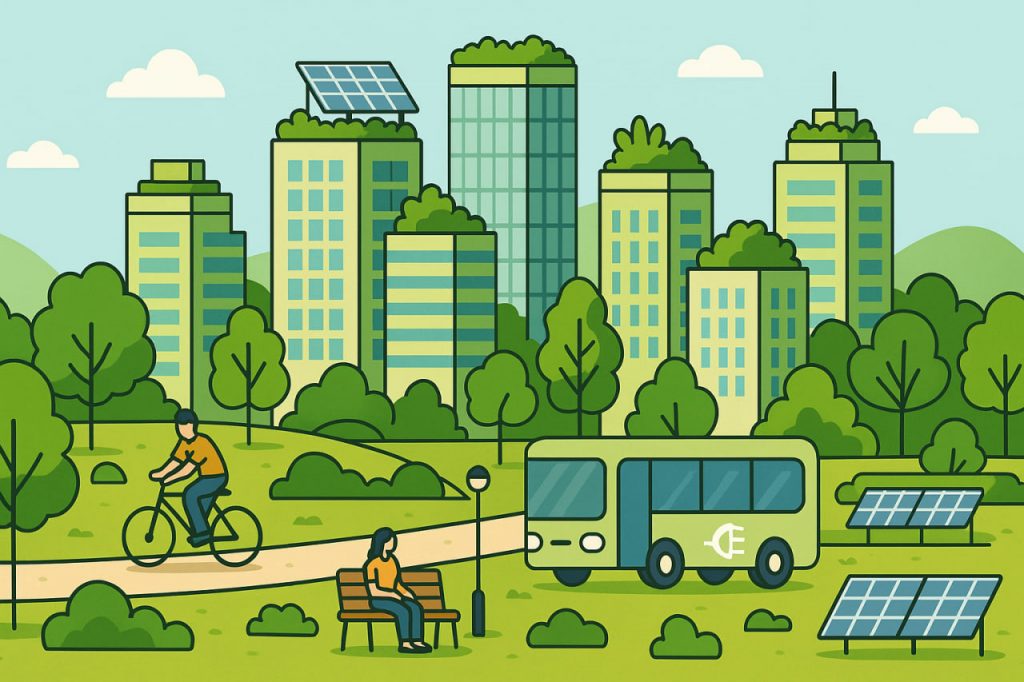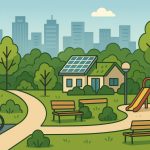A green city is an urban area designed with sustainability, ecology, and human well-being in mind. Such cities integrate renewable energy, green spaces, eco-friendly buildings, and efficient public transport systems to reduce environmental impact while improving quality of life.
Historical Development
The concept of green cities emerged in the late 20th century as a response to rapid urbanization, industrial pollution, and climate change. Early initiatives included creating urban parks, expanding bike lanes, and introducing recycling systems. Today, entire city models are being planned with sustainability at their core.
Key Features of Green Cities
Green cities focus on environmentally friendly solutions such as:
- Renewable energy (solar, wind, hydro).
- Efficient public transportation with electric buses and metro systems.
- Green architecture, including energy-efficient buildings and green roofs.
- Waste recycling and water reuse systems.
- Urban forests and parks to maintain biodiversity.
Benefits for People
Residents of green cities enjoy cleaner air, reduced noise, and healthier lifestyles. Accessible green spaces promote physical activity and mental well-being. Improved transportation reduces traffic congestion, while renewable energy lowers pollution and dependence on fossil fuels.
Environmental Importance
Green cities help combat climate change by reducing carbon emissions. They also protect biodiversity by integrating ecosystems into urban areas. Rain gardens, permeable pavements, and wetlands reduce the risk of flooding and improve water quality.
Challenges of Building Green Cities
Despite the advantages, green cities face challenges: high initial costs, complex planning, and the need for political and social support. Balancing rapid population growth with sustainability is a major issue for urban planners.
Conclusion
Green cities represent the future of urban development. By combining innovation, ecological responsibility, and social well-being, they provide a model for how humanity can thrive without exhausting the planet’s resources.
Interesting Facts
Modern urban areas generate about 70% of global CO₂ emissions, yet they also offer the greatest potential for change. Cities like Copenhagen, Singapore, and Vancouver are leading the way with green roofs, electric transport, vertical gardens, and zero-waste policies. Interestingly, green infrastructure — such as urban forests, bioswales, and permeable pavements — not only cleans the air and water but also lowers city temperatures through natural cooling. The integration of smart grids and energy-efficient buildings allows cities to optimize resource use in real time. Moreover, the shift toward circular economies ensures that materials and energy are continually reused instead of discarded. In essence, green cities demonstrate that sustainability is not a distant ideal but a practical blueprint for healthier, more resilient urban living.
Glossary
- Green city – an urban area designed to minimize environmental impact and maximize sustainability.
- Renewable energy – energy from natural sources that replenish themselves.
- Green architecture – design of buildings with ecological efficiency in mind.
- Urban forest – a collection of trees and green areas integrated into a city.
- Carbon emissions – release of carbon dioxide into the atmosphere from human activity.
- Sustainability – the ability to meet current needs without harming future generations.


